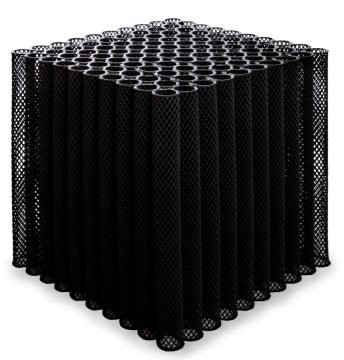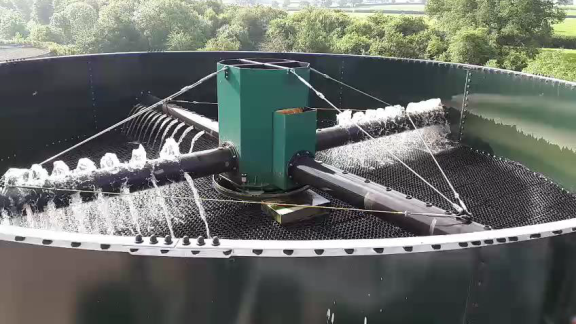Water shortages, hosepipe bans and sewage discharges into rivers, watercourses and the sea at popular beach locations, were all making media headline news in the UK over the summer.
The large number of sewage discharges being made in some parts of the country is a consequence of existing regional wastewater treatment works struggling to keep up with the increased amount of sewage being produced in some regions.
To avoid effluent backing up into homes, public buildings and commercial premises, sewage has to be periodically discharged into the environment. UK water companies are actively working on expanding and upgrading wastewater treatment facilities to meet the ever growing volumes of urban and rural wastewater produced as a consequence of continued population growth, and to meet demand from commercial, industrial and agriculture businesses.
EXPO-NET is helping the water industry to address the ongoing sewage overflow issue with its innovative, polyethylene BIO-BLOK® open mesh net tubes, specially designed to operate as a highly efficient biological fixed filter media in a wastewater treatment plant.
Alternative Biological Filter Media to Cross Flow

BIO-BLOK is part of the extensive range of extruded thermoplastic net and mesh products which have been produced and supplied worldwide by EXPO-NET Danmark A/S since 1959. The company’s head office, extrusion lines, R&D and engineering teams, production machinery workshops and main warehousing facilities are located in Hjørring, Denmark. Customers are supplied directly and via its international network of approved distribution and installation partners.
EXPO-NET works with its principal UK wastewater design and solutions provider, Cougar Wastewater, to provide water companies with lower cost, higher performance treatment systems. Solutions are found for either new plants or to upgrade existing works with customised filtration units to meet the needs of each individual project. Flow and load calculations are carried out using BIO-BLOK as the alternative fixed filter media to the more traditional cross flow media historically specified for the biological treatment of wastewater.
A number of Cougar wastewater installation projects in recent years have successful delivered a 40% increase in treatment performance using BIO-BLOK instead of a standard 60o plastic cross flow media, and at a lower overall installation cost and smaller asset footprint. As a consequence, customers, water companies and shareholders all share in the tangible benefits provided by BIO-BLOK.
Innovative Fixed Film Design
The design of standard cross flow media consists of 60o cross flute fills manufactured from sheets of extruded plastic; individual vertical corrugated fill plates are welded together with predetermined gaps ranging from 8-38mm to the required media size specification. In contrast, the innovative BIO-BLOK fixed film filter media cube design is made up of strong, stiff, plastic net tubes with a 45mm inner diameter. Net tubes are extruded from polyethylene, which is an inert and 100% recyclable plastic; individual tubes are then welded together to produce BIO-BLOK cubes in a range of sizes.
The unique open mesh helical design of BIO-BLOK net tubes provides a biological filter media with a void percentage of 88%, 45mm diameter vertical clear passages, a vertical load bearing capability of ~4000kg/m2, and a net weight of only 69kg/m3. The cylindrical, open net configuration of BIO-BLOK not only provides complete accessibility to the filter media, but the active surface area increases as the biofilm grows, hence its superior filtration performance in use. With standard crossflow plate media in trickling/high rate filters the biomass growth gradually closes the gaps between the plates, reducing the clear passage and subsequent flow rate of the wastewater being treated. As a result, cross flow media requires frequent flushing cycles, compared with BIO-BLOK which, being self-cleaning, does not need flushing as the speed at which the filter runs keeps it continually clean.
Depending on the size requirements of a wastewater works, BIO-BLOK filter units are constructed offsite as ‘ready to install’ cubes from 8×8 or 10×10 net tubes welded top and bottom. Standard cubes are 55 x 55 x 55cm, with alternative custom made net tube lengths from 45cm up to 120cm.
BIO-BLOK is self-supporting, does not require a retention system and is strong enough for installers to be able to stand on the cylindrical tube ends. During installation each layer of the bio-tower becomes a safe working platform to manually position the next filter media layer. Being so lightweight, BIO-BLOK cubes are easy to handle safely and rapidly install manually without specialist lifting equipment.
BIO-BLOK has been designed to provide optimum oxygen conditions and a higher volume of bacteria living on the BIO-BLOK media to maximize the purification of the wastewater faster. The unique design provides superior performance for biological removal in four key ways:
The cylindrical open mesh provides a much greater overall specific surface media area available, typically>70% more than using a conventional crossflow media (e.g. BIO-BLOK 268 m2/m3 [1mm biomass] versus cross flow 150m2/m3 assuming complete access to all of the media.) As a consequence, the land (asset footprint) and overall volume space needed with BIO-BLOK is around 50% less.
A 45% increase in treatment performance is achieved compared to a conventional cross flow media. This is due to BIO-BLOK’s unique cylindrical open mesh helical structural design being combined with a specially extruded rough surface texture onto which the biofilm growth can easily attach. The result is that a greater volume of wastewater is retained longer as it winds down each helix. Each net tube also retains a much higher number of bio-organisms on the larger accessible surface area, hence BIO-BLOK’s superior biological filter media growth performance capabilities.
BIO-BLOK operates on a hydraulic surface loading ranging from 3m3 p/m2 p/hr to 10m3 p/m2 p/hr at a constant speed providing a low maintenance filter which is continually clean and well oxygenated. Crossflow media has a much lower hydraulic surface loading from around 0.5m3 p/m2 p/hr to 1.6m3 p/m2 p/hr, resulting in biomass build up which requires regular flushing cycles, along with forced ventilation in some cases to keep the filter healthy. As a consequence, the capital, maintenance and operating costs of a treatment plant are much lower using BIO-BLOK as the filter media.
The two key water industry quality compliance parameters of maximum biochemical oxygen demand (BOD) and Ammoniacal Nitrogen content per litre for the final effluent after the biological treatment are both not only met, but exceeded by over 45% with BIO-BLOK.



